Stock Market Index Trading Strategy: 3 Tips For Massive Gain
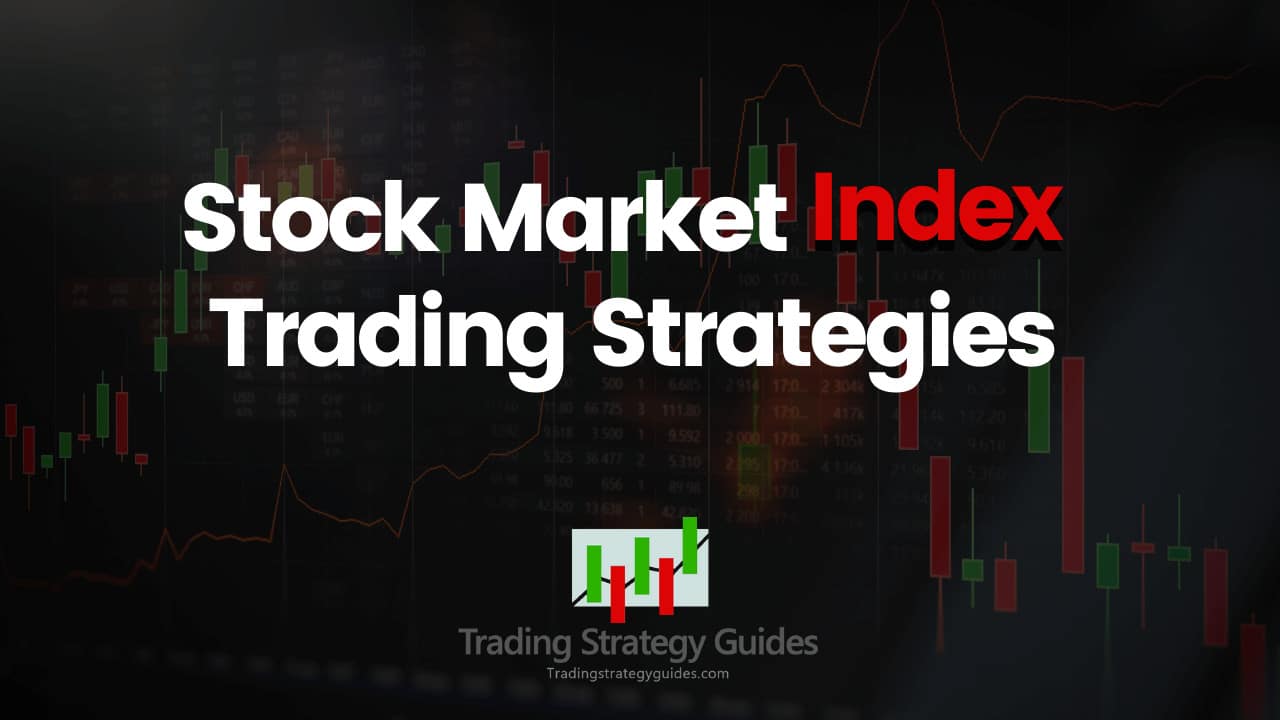
Learn the best stock market index trading strategy by trading ETFs. Index trading allows you to speculate on the price movement of the major world stock market indices. Throughout this guide, we’re going to write everything you need to know about stock market index trading. After reading this guide, you’ll be able to take advantage of some of the best index funds, including the Dow Jones Industrial Average, the S&P 500 Index, NASDAQ, and more.
If this is your first time on our website, our team at Trading Strategy Guides welcomes you. Make sure you hit the subscribe button so that you can get your Free Trading Strategy every week directly into your email box.
Also, check out our Stock Trading 101 Guide!
Indices trading is not exclusive to stock index traders because many Forex traders have access to CFD index trading with their broker. Futures Traders can also trade several indices.
ETFs enable traders to own a stake in the entire index without actually buying every stock in the index. Stock indices (NASDAQ, S&P 500, Dow 30, Nifty 50, etc.) are unique instruments because the whole world is talking about them.
Based on the particular features of these trading instruments, we want to share with you some of the best stock market index strategies.
Not all stock indices are created equal. Some indices are more representative than others.
Throughout this stock index trading guide, we’re going to cover some top trading tips and show you the best indices strategy.
Moving forward, we’re going to keep it pretty basic and start with a definition of what is index trading and how a stock index is calculated and then move along with 3 stock market index strategies.
Be sure to check out: FirstRateData
Table of Contents
What is Index Trading?
Index trading is a type of trading strategy that buys and sells a basket of stocks, which makes up the stock index. In other words, with stock index trading you gain exposure to the whole market, and you’re not tight to the performance of one single stock. Index trading is one of the easiest ways to diversify your current portfolio.
A stock index is essentially a representation or a benchmark of how the stock market is doing as a whole
The stock index composition is constructed by different rating agencies, and they are composed of many stocks.
An example of a rating agency is S&P Global Ratings, known as Standard & Poor’s, which has put together the S&P 500 index and Dow Jones Industrial Average (Dow 30 Index). This is one of the easiest ways for traders to gauge “the economy” as a whole.
For example, the day trading S&P 500 index is considered a leading US economic indicator, and it’s made it tracks the stock performance of 500 publicly traded companies listed on US stock exchanges. In the same way, the DAX 30 is a stock market index that measures the performance of the 30 largest German blue-chip stocks listed on the Frankfurt Stock Exchange.
Here is a breakdown of the S&P 500 constituent list of stocks (top 10 largest US stocks):
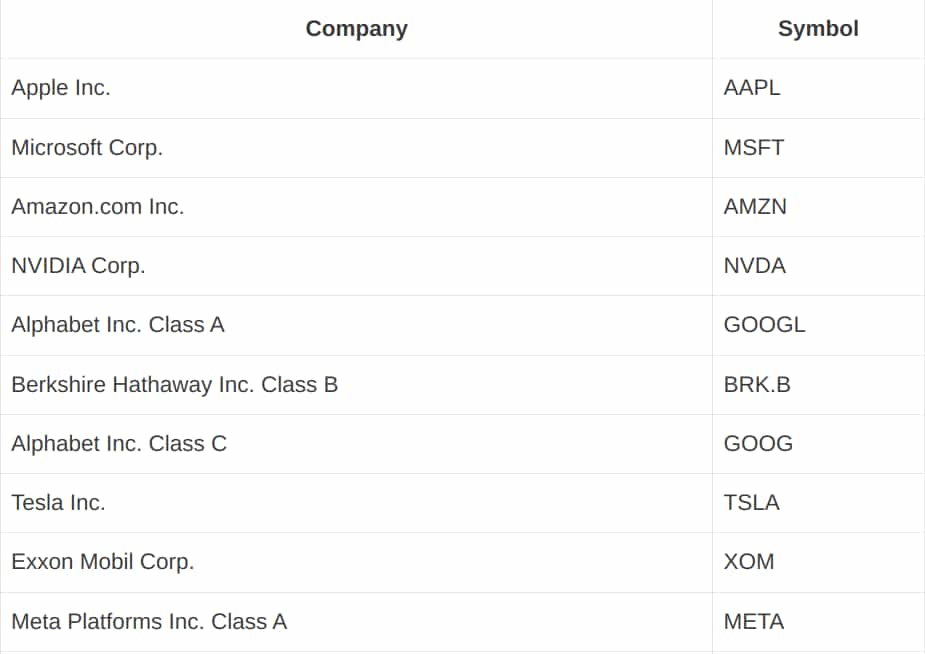
Now, if you want a zoomed-in picture of the S&P 500 stock composition by sector, see the chart below:
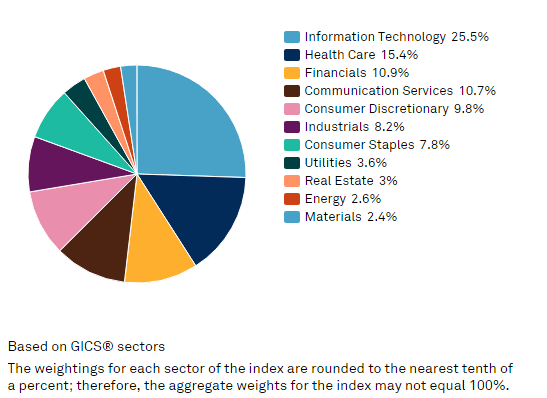
Check out a very unique S&P 500 stock index trading strategy here: The 3-bar Strategy.
Now, besides the US stock market indexes, we also have national stock market indexes all around the world:
- European stock market index (DAX 30 index in Germany, FTSE 100 index in the UK)
- Stock market index India (Nifty 50)
- China equity market index (Shanghai SE Composite Index)
At the same time, we also have global stock market indexes (for example MSCI World Index) and regional stock market indexes like Euro Stoxx 50 Index.
Buying stock indices directly is not possible, since an index is just a benchmark.
You can start trading stock indexes using futures vs options contracts, but our preferred way to index trading is through an Exchange Traded Fund (ETF).
Let’s move on and see how a stock index is created.
How is a Stock Index Calculated?
To understand how a stock index is calculated, you need to know that there are different types of stock market indexes:
- Market Value-Weighted Index (stocks with larger market capitalization weight more than smaller companies). An example of a market value-weighted index is S&P 500.
- Price-Weighted Index (the index is calculated using the stock price rather than the market capitalization). An example of a price-weighted index is the Dow Jones Industrial.
As an example, we will show you how the value of the S&P 500 index is calculated.
Now, each stock in the S&P 500 stock index composition has a certain percentage weight.
See the S&P 500 index components by market capitalization below:
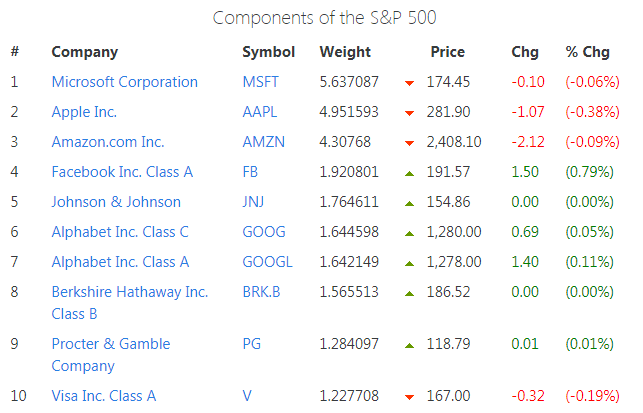
Here is the mathematical formula used to calculate the value of the S&P 500 index:
Index Level=Divisor∑i=1nPi × IWFi × Shares
Where:
Pi=Price.
IWFi = The equal weighting percentage.
On the other hand, here is how to calculate the Dow Jones value:
Since, DJIA is a price-weighted index, we sum up all the 30 stock prices that make up the index and then divide the sum by an index divisor (0.145233).
Next, we’re going to outline the complete guide on how to trade indices online.
See below:
How to Trade in Index?
We‘re going to take the approach of how we generally see the stock index market behaving.
We’re going to establish some stock indices trading principles that are grounded in our research on historical stock index prices.
If you want to learn how to trade in the index, you’ll need to start by understanding how the stock market, as a whole, typically behaves.
Generally, from our historical tests, the stock market tends to behave in a particular way.
The stock market tends to systematically climb, and every once in a while, stock indices experience sharp declines that can lead to a recession or even depression. However, even during bearish conditions, there will still be plenty of opportunities to earn a profit. Learn how to trade stocks in a recession.
- The bullish stock market cycle is characterized by a slow and persistent manner of price increases.
- While the bearish stock market cycle is characterized by a sharp decline in prices.
As the saying goes:
“The stock market takes the stairs up, and the elevator down.”
In the stock index chart below you can see how steadily the prices are crawling higher and on the way down it plunges:

With this in mind, we can apply some stock market index trading strategies on the intermediate time frame and the intraday charts. Once you train yourself to recognize these common stock indices patterns, you can safely trade on the most traded markets globally.
Traders from all over the world ask us all the time:
- “What is the best way to stock index trading?”
- “What is the best way to trade the S&P 500, Dow 30, DAX, Nifty 30?”
Generally speaking, all stock indices exhibit the same price behavior (as explained above).
When we get these types of questions, our advice is not to try to call a top during a bullish stock cycle. Conversely, don’t try to pick a bottom during a bearish stock market cycle.
Only novice traders will try to short the market in an uptrend just because it’s too high or it’s overbought. Experienced traders, on the other hand, are typically a bit more patient.
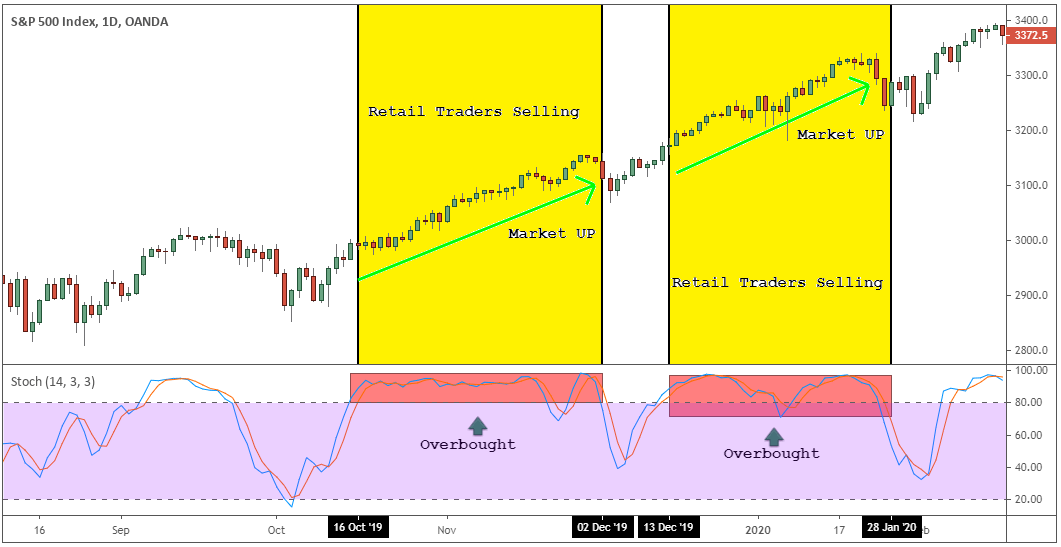
While it’s true that markets do get overvalued and we’re going to see a serious correction, over the long term the overall stock market direction is bullish. Using technical trading indicators can help you determine which direction the trend is currently moving.
We know you clicked on this article to learn trading strategies for trading stock indices, which is what we’re going to discuss in the section below:
Stock Market Index Trading Strategies
Throughout this section, we will outline the best index trading system by highlighting three stock market index trading strategies that every trader needs to know. We’re going to simply “plant the seed” that can grow into an index trading strategy that is suitable for your trading style.
Index Trading Strategy #1: The 3 Days Drive
How do we go long on a stock index?
Our primary trading approach is to enter the market during pullbacks.
Check out our guide for How to Profit from Trading Pullbacks.
While this is not a 100% foolproof strategy, it can still be very effective.
According to our research into the stock index performance, we’ve noted that on average pullbacks last 3 days.
Here are the setup trading rules for buying a stock index:
- Wait for three (or two)consecutive daily red candles.
- On the fourth day (third day) wait for a pullback.
- If on the fourth day (third day) we break below the low of the third day wait until the market regains strength above the open price of the fourth day (third day).
See the S&P 500 index chart below:
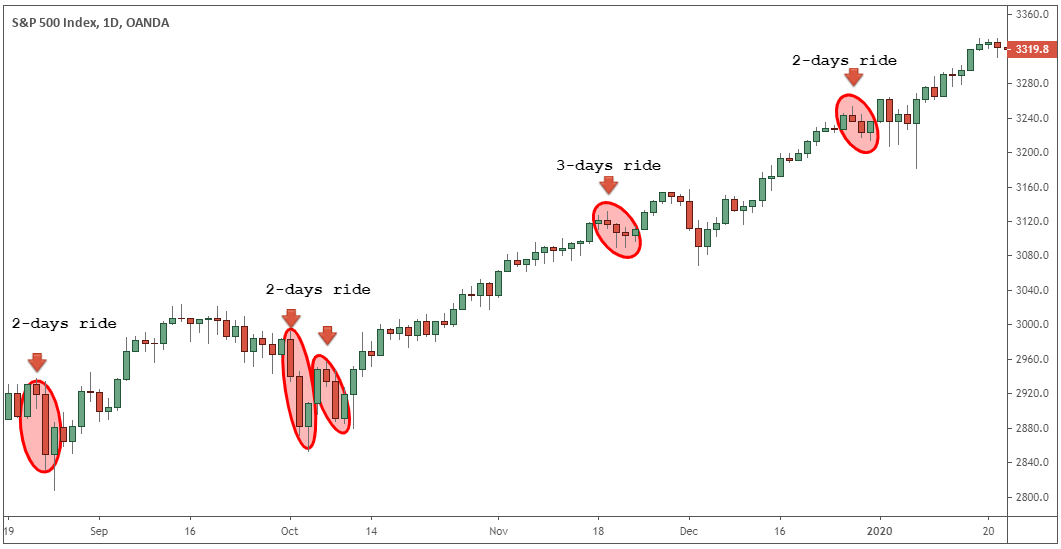
Watch Tim Black explain the 3 Days Drive!
Index Trading Strategy #2: How to Sell a Stock Index?
Selling a stock index is different from buying a stock index.
Generally, we like to be late when we are on the short side and early when we are on the long side.
If we want to buy stock indices, we’re more inclined to buy on dips. Since the stock markets are more likely to go up over time, even if we experience a short-term drawdown, it’s safer to assume that the market will resume.
See the S&P 500 stock index chart below:

However, if we want to include a short indices strategy, our approach is to sell when weakness is showing in the stock market.
Here is an example, if a stock index breaks down and has continued selling pressure, we look for short trading setups on the way down.
Let me make it more clear to you:
We sell along with the bearish momentum trading.
See the NASDAQ chart below:

It’s safer to sell stock indices when the market is starting to come down and revealing the downtrend price structure (lower highs and lower lows) than trying to do so on the way up.
Let’s see a way you can trade stock indices after big news announcements. Mergers, new trade deals, investments, scandals, and more can all cause a stock index to experience sudden movement. Additionally, consider using a trading calendar to help you anticipate when the most significant stories are likely to break.
Index Trading Strategy #3: How to Trade the News?
News-based trading events without a clear plan can be disastrous since usually, news lead to extreme price movements.
Some of the key market-moving announcements are:
- US Federal Reserve (FED) meetings.
- US Job Reports and unemployment rate (NFP report).
- And any type of news that has a high impact on the stock index price.
Our approach to news trading is to let the dust settle and trade based on the aftermath of the price reaction.
After a big announcement comes out and moves the market, if on that day the price closes at an extreme (we want the index price close to being near the high/low of the day) usually the next day we’ll see a follow-up in the same direction.
For example:
If good news comes out and the S&P 500 is right at the extreme, near the high of the day, then we want to buy at the opening of the following day.
See the S&P 500 index chart below:
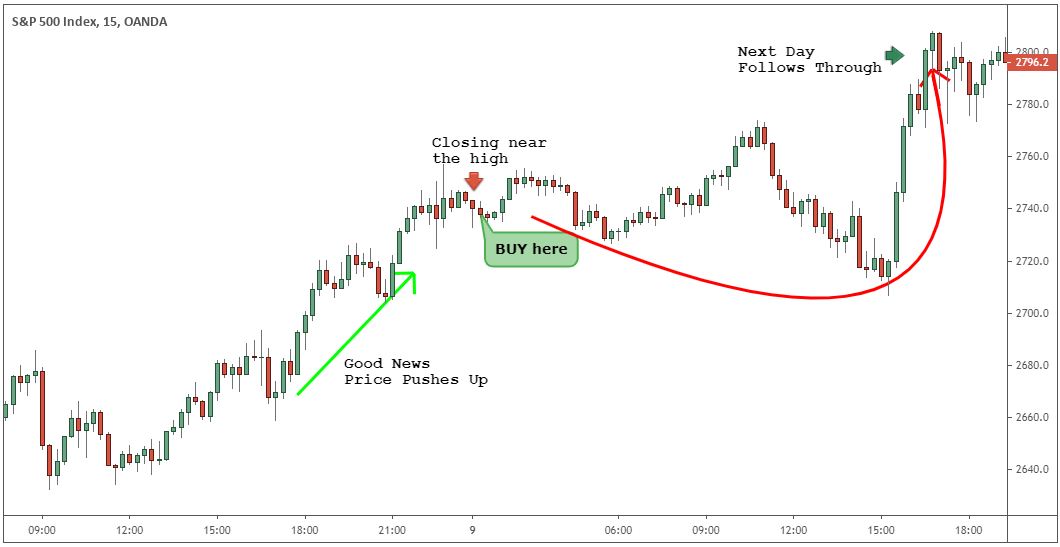
Note* If you’re on the long side you can keep this trade for one full day or for a further move to follow through.
Final Words – Stock Index Trading
In summary, the best index trading strategy is considered to be a relatively stable way to invest your money. To be a winner, you need to try not to call tops in uptrends, but rather just work with the dips and get out if you’re wrong but let it run if you’re right. In the long run, it’s better to buy stock indexes at a good discount rather than to try to sell a market that is gaining in value. There are also technical indicators to buy stock.
The most important thing in index trading is to choose the right index instrument and contracts that are applicable to your account size and risk tolerance.
Here is a short recap of the three stock market index trading strategies you have learned today:
- The 3-day drive to buy pullbacks.
- Selling with the bearish momentum on the downside.
- Stock index news trading.
Thank you for reading!
Feel free to leave any comments below, we do read them all and will respond.







Good lecture
Thank you!
thanks for sharing information about stock market trading .